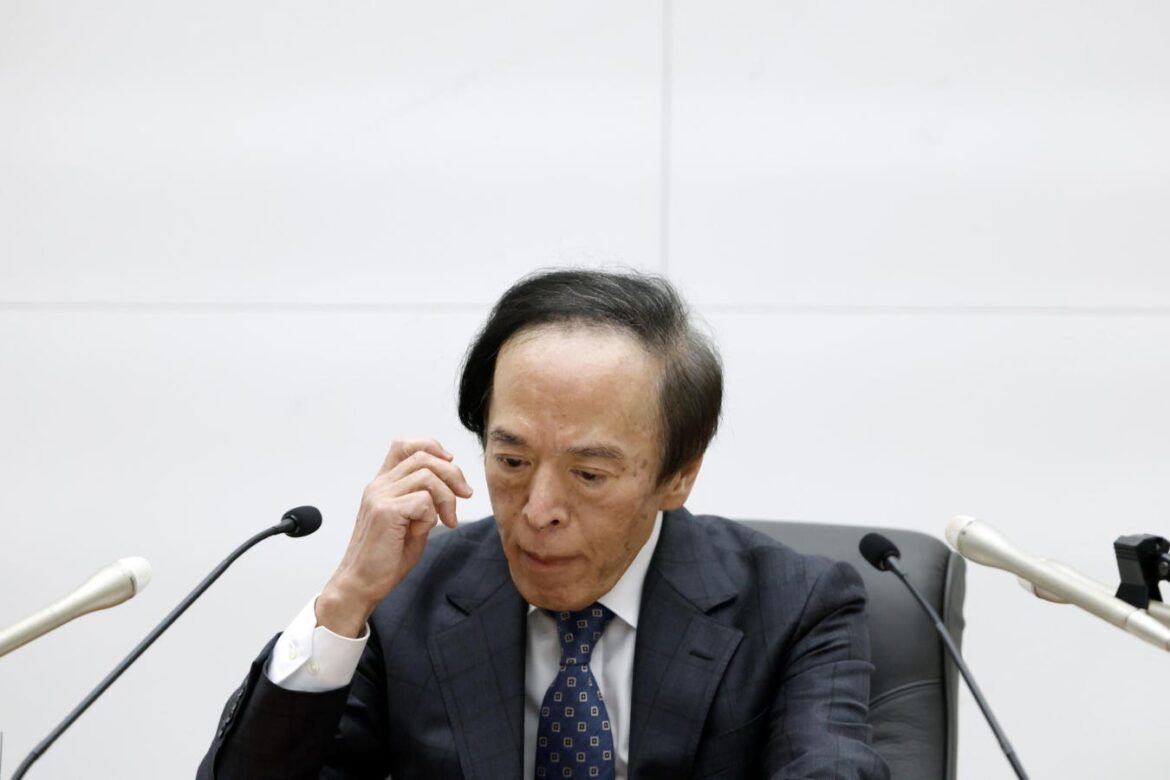Kazuo Ueda, governor of the Bank of Japan (BOJ)
Kiyoshi Ota/Bloomberg
Donald Trump’s quixotic trade war appears to have entered the tilting-at-windmills phase as the U.S. president sees “big, beautiful” deals that just don’t seem to be there.
It was news to Xi Jinping’s people in Beijing that “he’s called” Trump and that Trump has “spoken to him many times” about a free-trade pact between the two biggest economies. Beijing’s response? China’s Foreign Ministry would prefer that Trump’s White House not “mislead the public” on the state trade negotiations.
Japanese officials were put in an awkward position recently when Trump World claimed a deal was imminent between the No. 1 and No. 3 economies. Tokyo pushed back gingerly, noting that, actually, Ryosei Akazawa, Japan’s minister of economic revitalization and point person in the talks, had already returned home.
As Japanese Prime Minister Shigeru Ishiba told parliament on April 14: “We don’t intend to make one compromise after another to conclude negotiations swiftly.”
Yet one compromise that Tokyo is almost certainly making this week is the Bank of Japan halting its rate hike cycle, a decision that Trump’s fingerprints are all over.
Like most major monetary authorities, the BOJ entered 2025 figuring Trump’s tariff talk was more a negotiating tactic than a real threat. Maybe a 10% Trump tax here or there, but not a Japan-specific 24% reciprocal tariff, or a 25% levy on autos. And most certainly not a cartoonishly large 145% tax on China, Asia’s main economic engine.
The headwinds from these actions are forcing BOJ Governor Kazuo Ueda to change his calculus in real time. A month ago, the BOJ seemed full-speed ahead to kick its rate normalization campaign into a higher gear on May 1, hiking its benchmark to 0.75%. Now, virtually no one thinks Ueda will tighten.
Trump’s tariffs have been an absolute game-changer for Tokyo. Hopes that Ishiba could strike up some kind of bromance with Trump to win Japan a tariff carve-out have been replaced with economic paranoia.
In March, Japan’s industrial production fell 1.1% from February. To Stefan Angrick at Moody’s Analytics in Tokyo, the drop “reinforces the impression that Japanese producers were already looking vulnerable before U.S. tariffs and tariff threats further scrambled the outlook.”
Industrial production remains below levels in 2021, when Covid-19 was in full swing. “Manufacturing,” Angrick says, “has gone from bad to worse since the pandemic, grappling with supply-chain disruptions, domestic production hiccups, and increased foreign competition.”
At the same time, the yen’s nearly 10% rally so far this year puts exporters in an even more precarious position. Ueda, especially, as the BOJ risks sending the yen even higher.
At a moment when China is exporting deflation, a surging yen could tip Japan back into recession. It could give global investors who drove the Nikkei 225 Stock Average to record highs in 2024 second thoughts. And it could unnerve global currency and bond markets.
Twenty-six years of zero rates morphed Japan into the top creditor nation. It became common practice for investment funds everywhere to borrow cheaply in yen to bet on higher-yielding assets around the globe. The resulting “yen-carry trade” going awry is one of hedge fund managers’ biggest fears.
For Ueda, the fear is that his two-year effort to end Japan’s deflation-era rate policies will have been in vain. In January, Ueda managed to raise rates to a 17-year high of 0.5%. That had Japan Inc. thinking the zero rate policy instituted in 1999 was finished. Ditto for the quantitative easing strategy the BOJ pioneered in 2001.
Then came Trump 2.0’s ginormous trade war.
Given the economic carnage the tariffs are causing, it’s not a reach to worry the BOJ’s next move could be to cut rates, not hike them. That could happen if the U.S. slides into recession, many fear.
It happened in 2006 and 2007, the last time the BOJ tried to “normalize” Japan’s rate environment. That fizzled when the 2008 “Lehman shock” arrived. Could Trump’s trade war unleash similar carnage?
It’s odd to hear talk about his trade war in such delusional terms, like some hero on a 17th century adventure novel pursuing a foolish pursuit. Cue the Don Quixote references.
Along with Trump’s growth-killing tariffs arms race, China is already sharing its overcapacity troubles with the world. This puts Japan in the middle of two economic giants at risk of stumbling in different ways.
Japan is also heading into a July national election that’s as uncertain as they come. Though Ishiba’s Liberal Democratic Party thinks it has a firm hold on power, the prime minister’s approval rating is around 26%. Ishiba makes Trump seem downright popular.
With so many risks rushing Japan’s way, there’s nothing “beautiful” about Japan bracing for what a delusional U.S. leader might do next. At least in the case of the BOJ, it’s to do nothing on Thursday and pray from a happy ending.


AloJapan.com